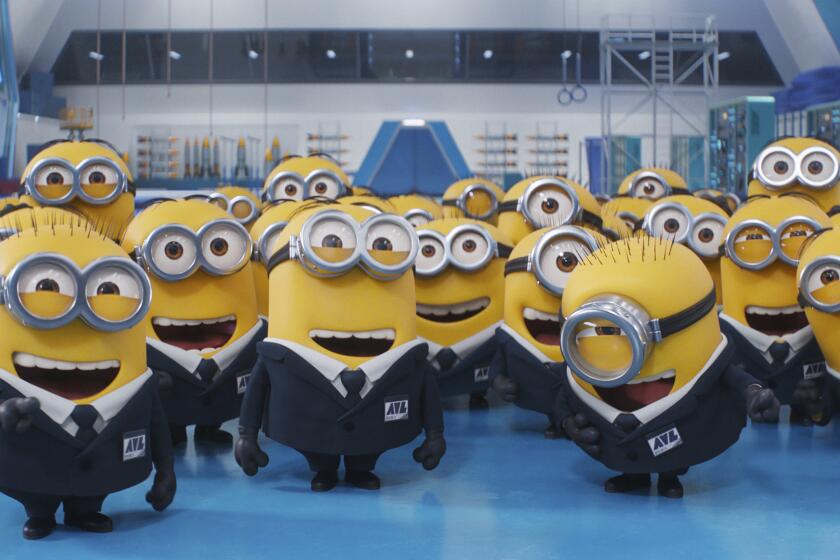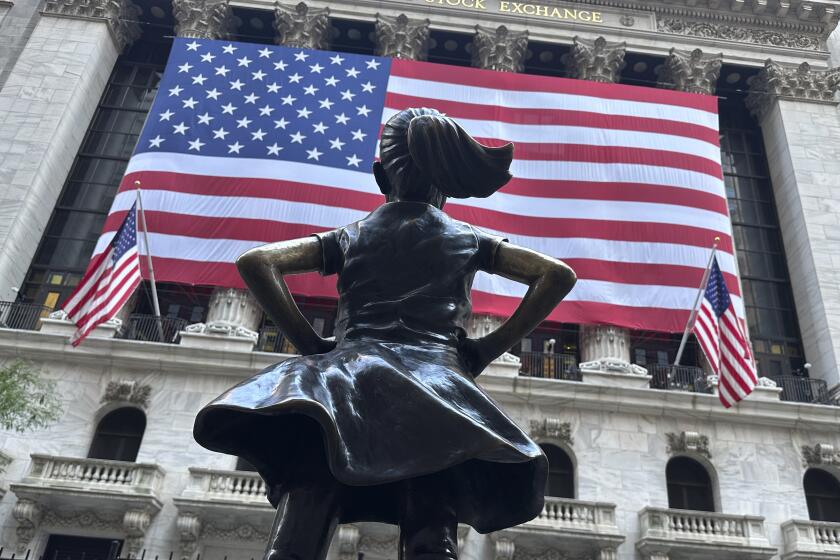The Rise and Decline of Vector Graphic : Management Mistakes and IBM Crush Couple’s Computer Venture
Remember Lore Harp? The housewife-turned-MBA who was splashed on the cover of Inc. magazine, lionized in Savvy and interviewed at reverent length by the Harvard Business Review?
If you have forgotten, it’s not surprising. Vector Graphic, the company Lore and Bob Harp founded nine years ago on their kitchen table in Westlake Village, was ambushed a few years back by management blunders and a good-sized competitor by the name of IBM.
Today Vector is as shrunken as a punctured beach ball and right back in Westlake Village--practically on a kitchen table again.
Vector’s history is a classic story of success and failure in the computer business, a cautionary tale for energetic entrepreneurs caught up in the mystique of management.
The company is controlled these days by the ill-starred venture capitalists who helped fund it. Few people work there. Its stock has plummeted.
Merger Postponed
And now the company, whose chief executive boasted of facing down Wall Street underwriters with her unyielding demands, is wanted mostly for a transferable tax loss exceeding $10 million. Even so, a proposed merger to exploit the loss has been postponed.
The Harps, meanwhile, are divorced.
At its peak in 1982, Vector Graphic was a computer company with $36.2 million in sales, $2.4 million in profits and an important place in the up-and-coming personal-computer industry. It had 425 workers in a huge Thousand Oaks facility,
What went wrong? “It was a series of blunders,” said Donald Sinsabaugh, who used to follow the company for the securities firm of Swergold, Chefitz & Sinsabaugh in New York. Lore Harp, he said, “is not to blame alone. But she was the leading light of that company. Being the person who would have taken the credit, she’s the one who has to live with the failure.”
Sinsabaugh said he doesn’t follow Vector anymore, because “no one cares about dead horses.”
Both Harps have moved on to other things. Bob is chairman of Corona Data Systems, a privately held computer company in Thousand Oaks that he founded a month after leaving Vector. Corona, which posted sales of $64 million last year, reported turning its first profit last year and that it is roughly breaking even this year.
Success Story Turned Sour
Lore Harp is in San Mateo, where she has started a new company, Aplex Corp. Earlier this summer, she said it was planning to patent a feminine hygiene product.
She is reluctant to talk about Vector now. But when she does, she says several things turned her success story sour--”the entry of IBM,” “too many cooks stirring the broth” and, finally, “lots of things.”
A strong-willed German emigrant, Lore Harp was 32 back in 1976 and dissatisfied with her comfortable suburban life as mother and homemaker. She tried law school, but the workload, coupled with the demands of her family, were too much. At the same time, her husband, who holds a Stanford doctorate in electrical engineering, was looking for someone to market a computer memory board he had designed.
Bob Harp was working for Hughes Research Laboratories, and Lore Harp wanted to start a business. So she and the Harps’ next-door neighbor, former bond trader Carole Ely, decided to market the memory board themselves.
After the company was mapped out in the kitchen, the headquarters became the downstairs bedroom. Capital was $6,000. The product was a kit for Bob’s circuit board, a device to expand a computer’s memory, packed on the floor by Ely and Lore Harp. Letters signed by Lore Harp had LH/mtf typed in the corner, which looked official, but stood for “Lore Harp/my two fingers.”
Bowls Held Components
Growth was accommodated by getting bowls from the kitchen to keep the little components separated. The children were enlisted as assemblers. Later, high school students were hired part time.
In December, 1976, five months after incorporating, Vector moved to 1,200 square feet of rented space and hired two full-time workers. Five months later it moved into even larger quarters.
Once the company was a going concern, Bob Harp quit Hughes and joined Vector full-time, designing its first full-scale personal-computer system. It hit the market in 1977, and Vector was off and running, in the forefront of the personal-computer boom. The company soon became a leader in small, multiuser systems.
By 1980, Lore Harp had obtained her MBA from Pepperdine University, and, by her account, felt challenged and fulfilled in her role as president and chief executive. Bob Harp was chairman and vice president for research and development, using his expertise to design Vector’s products.
Curse of Fixed Keyboard
Those products were well-regarded generally, but they weren’t perfect. Critics complained that the Vector 3, for example, was uncomfortable to use.
“The thing that killed the Vector 3 was a fixed keyboard,” said Michael Murphy, editor of the California Technology Stock Newsletter. “It never caught on.”
Nevertheless, the company’s growth was rapid. For the year ended June 30, 1977, sales were $400,000. The next two years they were $2 million and $4.9 million, respectively.
For the year ended June 30, 1980, Vector earned $1.3 million on sales of $11.9 million. The next year, earnings were $2.6 million on sales of $25 million. About four months later Vector went public, and the Harps were in the money.
‘Accepting the Challenge’
“I’m a million and a half dollars richer, and it’s totally unimportant . . . “ Lore Harp told the Harvard Business Review in the interview published in the summer of 1982. “What I really enjoy is growing the company, growing people within the company, accepting the challenge of being out there, competing against other companies and making an impact. Power may have something to do with it as well. I won’t deny that.”
But Vector already was past its prime. IBM introduced the IBM-PC in August, 1981, the year of Vector’s greatest profit, and by 1982 the decline had begun. Vector still made money and showed record sales. But net income fell from $2.6 million to $2.4 million for the year ending June 30, 1982, and the per-share decline was even sharper--to 43 cents, from 52.
One reason was that the company announced its new Vector 4 computer prematurely. Vector 4 was a kind of bridge system. Although not fully IBM-compatible, it ran software for IBM as well as for the CP/M system, the most common other operating system then on the market. It also had a detached keyboard.
Unfortunately, the accidental announcement of the product in April--somebody in marketing placed an ad prematurely, according to Bob Harp--immediately put a damper on sales of the older Vector 3, backing up millions of dollars in inventory. Even worse, Vector 4 wasn’t ready for shipment until four months later.
Slow to Adjust to IBM
Vector was slow to adjust to the dominance of IBM, Murphy said, and to this day it still doesn’t make a machine that is fully IBM compatible.
April of 1982 was the cruelest month for Vector in other ways, too: It was when Bob Harp left.
“It was a dispute over who would run the company, and she prevailed,” Bob Harp said recently.
A month after leaving Vector, he founded Corona and the couple were divorced soon after that.
Bob Harp’s departure hurt the company severely, according to Sinsabaugh, and, coupled with the Vector 4 snafu and the entry of IBM into the market, it helped propel Vector’s long slide. Bob Harp blames the slide on his ex-wife.
‘Didn’t Develop New Projects’
“They didn’t develop any successful products after I left there,” he said. “If the proper decisions had been made, it would be quite successful.”
“They were so convinced they were on track that they didn’t develop new products,” said Bernardus Smit, president of Dual Systems Control Corp., Vector’s proposed merger partner.
Bob Harp also complains that the birth and near death of Vector cost him more than his marriage. He liquidated the remains of his million-share stake in the company last year for 10 cents a share. At one time shares sold for $17; now they’re worth about 31 cents.
The focus on Lore Harp intensified about the time of her husband’s departure. She had already been on the cover of Inc. in 1981. Then came the Harvard Business Review interview.
‘Very Fast Decisions’
Asked if risk-taking was a problem, as it is sometimes alleged to be for female entrepreneurs, Harp responded: “Not at all, because one of the things I can do is make very fast decisions. . . . What makes me so mad many times during staff meeting is when people come up with reasons why something can’t be done. I say, ‘Why don’t you give me just one reason why it can be done?’ ”
Savvy did a piece in July, 1983. In it, Lore Harp cited management guru Peter Drucker on the challenge of managing turmoil. She acknowledged turmoil at Vector, but said she had learned from it.
“I know I’m a much stronger manager now--this has been a time of great personal growth for me,” she was quoted as saying. “The spirit here is, once again, tremendous; people are committed. And right now I demand a 150% commitment or I say, ‘get out.’ ”
She said she also ordered an end to memos: “I say, look the person in the eye, discuss the problem. Only write down action items and policy matters.”
‘Take Careful Aim’
The Savvy article recognized Vector’s troubles--it lost $3 million in the 12 months ended June 30, 1983--but suggested the company would prevail.
“Harp’s got the strength,” the article concluded. “All she has to do is pull the slingshot back far enough and take careful aim with the stone.”
Bob Harp scoffs at all this, arguing that the people running Vector got caught up in their executive roles instead of concentrating on the products that would make or break the company.
“The people there started to act like managers,” he said, “when that may not have had anything to do with their success.”
But Lore Harp, who finally left Vector at the end of 1983, said products were far from ignored.
‘It’s Sad’
“We had fantastic stuff on the drawing board,” she said, adding, “It’s sad.”
The company’s chairman now is Jean Deleage, a San Francisco venture capitalist whose firm, Burr, Egan, Deleage & Co., held about 21% of Vector’s stock as of June 30, 1984, according to Vector’s 1984 annual report.
Vector is now being run by its proposed merger partner, Dual Systems, a privately held computer company in Berkeley.
Smit said Vector has about three dozen employees now, and recently moved from a 110,000-square-foot facility to its 10,000-square-foot headquarters back in Westlake Village. The new space is “more than enough,” he said, to handle office operations as well as the assembly and shipping of computers.
Dual has annual sales of $10 million to $20 million, Smit said. Dual is profitable, so it can take advantage of Vector’s tax losses, and it also wants to use the merger to become a public company, he said.
‘Practically a Gift’
“Probably it’s practically a gift,” said Murphy, the newsletter editor. “For the venture capitalists, it’s a way to exit the whole thing with some degree of honor.”
Smit said his plans for Vector are to pursue several market niches in which Vector is well-established, such as doctors’ and lawyers’ offices and the Arab world.
“The market is much more differentiated than most people have in mind,” he said.
But Smit said the merger has been postponed indefinitely, and he won’t explain why, except to say that many things have to be worked out before the letter of intent between the companies can be executed.
Officials of Vector did not return repeated phone calls for comment.






